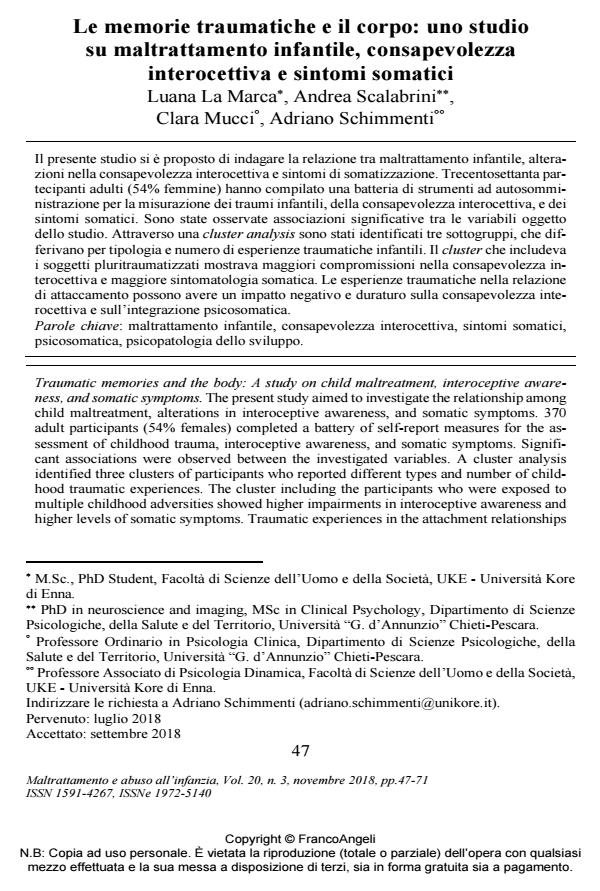Le memorie traumatiche e il corpo: uno studio su maltrattamento infantile, consapevolezza interocettiva e sintomi somatici
Titolo Rivista MALTRATTAMENTO E ABUSO ALL’INFANZIA
Autori/Curatori Luana La Marca, Andrea Scalabrini, Clara Mucci, Adriano Schimmenti
Anno di pubblicazione 2018 Fascicolo 2018/3
Lingua Italiano Numero pagine 25 P. 47-71 Dimensione file 381 KB
DOI 10.3280/MAL2018-003004
Il DOI è il codice a barre della proprietà intellettuale: per saperne di più
clicca qui
Qui sotto puoi vedere in anteprima la prima pagina di questo articolo.
Se questo articolo ti interessa, lo puoi acquistare (e scaricare in formato pdf) seguendo le facili indicazioni per acquistare il download credit. Acquista Download Credits per scaricare questo Articolo in formato PDF

FrancoAngeli è membro della Publishers International Linking Association, Inc (PILA)associazione indipendente e non profit per facilitare (attraverso i servizi tecnologici implementati da CrossRef.org) l’accesso degli studiosi ai contenuti digitali nelle pubblicazioni professionali e scientifiche
Il presente studio si è proposto di indagare la relazione tra maltrattamento infantile, alterazioni nella consapevolezza interocettiva e sintomi di somatizzazione. Trecentosettanta partecipanti adulti (54% femmine) hanno compilato una batteria di strumenti ad autosomministrazione per la misurazione dei traumi infantili, della consapevolezza interocettiva, e dei sintomi somatici. Sono state osservate associazioni significative tra le variabili oggetto dello studio. Attraverso una cluster analysis sono stati identificati tre sottogruppi, che differivano per tipologia e numero di esperienze traumatiche infantili. Il cluster che includeva i soggetti pluritraumatizzati mostrava maggiori compromissioni nella consapevolezza interocettiva e maggiore sintomatologia somatica. Le esperienze traumatiche nella relazione di attaccamento possono avere un impatto negativo e duraturo sulla consapevolezza interocettiva e sull’integrazione psicosomatica.
Parole chiave:Maltrattamento infantile, consapevolezza interocettiva, sintomi somatici, psicosomatica, psicopatologia dello sviluppo.
- Fybromialgia, interoception and risk factor for emotional dysregulation: A single case pilot study Michela Balconi, Laura Angioletti, in MALTRATTAMENTO E ABUSO ALL'INFANZIA 1/2020 pp.25
DOI: 10.3280/MAL2020-001003 - A meta-analytic review of child maltreatment and interoception Julia Ditzer, Christian Franz Joseph Woll, Clara Burger, Alisa Ernst, Ilka Böhm, Susan Garthus-Niegel, Anna-Lena Zietlow, in Nature Mental Health /2025 pp.821
DOI: 10.1038/s44220-025-00456-w
Luana La Marca, Andrea Scalabrini, Clara Mucci, Adriano Schimmenti, Le memorie traumatiche e il corpo: uno studio su maltrattamento infantile, consapevolezza interocettiva e sintomi somatici in "MALTRATTAMENTO E ABUSO ALL’INFANZIA" 3/2018, pp 47-71, DOI: 10.3280/MAL2018-003004